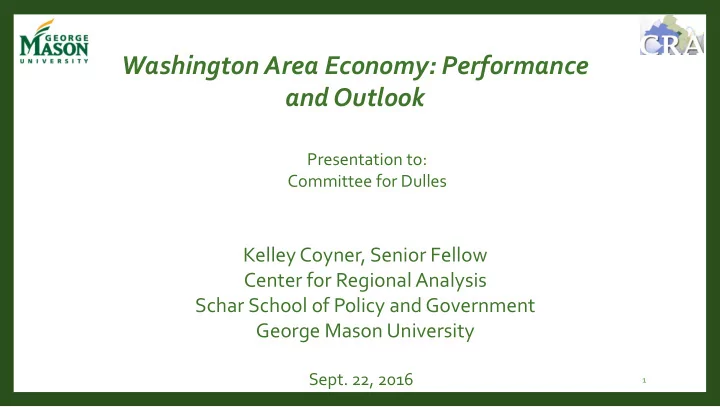

Washington Area Economy: Performance and Outlook Presentation to: Committee for Dulles Kelley Coyner, Senior Fellow Center for Regional Analysis Schar School of Policy and Government George Mason University Sept. 22, 2016 1
What’s new? Economic Trends ? Regional Implications? 2
5.2 % Real median household income 2.4 M More workers 1.2 % Decrease in poverty rate 3.5 M Fewer in poverty U.S. Census Bureau Income and Poverty in the United States: 2015 Current Population Reports Issued September 2016, P60-256 3
GDP Trends since 2001 140 135 130 125 2001 GDP*=100 120 115 110 105 100 Washington-Arlington-Alexandria, DC-VA-MD-WV MSA 95 United States 90 2001 2002 2003 2004 2005 2006 2007 2008 2009 2010 2011 2012 2013 2014 2015 4 Source: US Bureau of Economic Analysis, *2009 Chained Dollars
GDP New Numbers Courtesy of Washington Business Journal 5
Recession Recovery Patterns of GDP Past Four Recessions 40 40 35 35 30 30 25 25 % Change in GDP* 20 20 15 15 10 10 5 5 0 0 0 0 1 1 2 2 3 3 4 4 5 5 6 6 7 7 8 8 9 9 10 10 11 11 12 12 13 13 14 14 15 15 16 16 17 17 18 18 19 19 20 20 21 21 22 22 23 23 24 24 25 25 26 26 27 27 1982-Q3 1982-Q3 1991-Q1 1991-Q1 2001-Q4 2001-Q4 2009-Q2 2009-Q2 Quarters After Trough *in 1992 or 2009 Chained Dollars Sources: Bureau of Economic Analysis, GMU Center for Regional Analysis 6
15 Largest Job Markets Job Change: Jul 2015 – Jul 2016 (000s) 250 200 150 100 50 0 Source: Bureau of Labor Statistics (Not Seasonally Adjusted), GMU Center for Regional Analysis
Annual Job Change Northern Virginia, 2002-2016 (000s) Annual Data Annual Month over Year 60 2011 2012 2013 2014 2015 50 40 30 20 10 0 -10 -20 -30 2002 2005 2008 9 Source: Bureau of Labor Statistics (Not Seasonally Adjusted), GMU Center for Regional Analysis
WMSA Payroll Job Change: Private Sector Aug 2008-Feb 2010 Feb 2010-May 2016 (000s) 73 Prof. & Bus. Svcs -24 68 Educ & Health Svcs 0 Retail Trade 43 -23 86 Leisure & Hosp. -34 30 Construction -49 21 Other Services -8 9 Financial -10 Total -181 Total 335 Information -12 0 Manufacturing -10 Wlse Trade -7 4 Transp. & Util. -5 -100 -75 -50 -25 0 10 Source: Bureau of Labor Statistics (Not Seasonally Adjusted), GMU Center for Regional Analysis
Annual Change in Payroll Jobs – US Month-Over-Year (000s) 4000 Jun = 2000 +2.5M 0 -2000 -4000 -6000 -8000 11 Source: Bureau of Labor Statistics (Not Seasonally Adjusted), GMU Center for Regional Analysis
Professional & Business Services Washington MSA Annual Data Annual Month over Year 30 2010 2011 2012 2013 2014 2015 25 May-16 20 Total: 739.2 15 (000s) 10 5 0 -5 -10 -15 -20 2002 2005 2008 Feb May Aug Nov Feb May Aug Nov Feb May Aug Nov Feb May Aug Nov Feb May Aug Nov Feb May Aug Nov Feb May 12 Source: Bureau of Labor Statistics (Not Seasonally Adjusted), GMU Center for Regional Analysis
Population and employment trends in the Washington Metro Area Index of Population and Employment Growth in the Washington Region 130 125 120 Year 2000=100 115 110 105 Population 100 Employment 95 90 2000 2001 2002 2003 2004 2005 2006 2007 2008 2009 2010 2011 2012 2013 2014 2015 Source: US Census Bureau, Population Estimates Program; 13 Source: Bureau of Labor Statistics (Not Seasonally Adjusted), GMU Center for Regional Analysis US Bureau of Labor Statistics, Current Employment Statistics
Washington Metro Area Population Components of Change 100,000 4,495 80,000 47,495 43,070 36,871 60,000 40,000 Net Domestic Migration Net International Migration 47,989 47,150 46,096 20,000 Natural Increase - (20,000) (24,741) (27,907) (40,000) Source: Census Bureau 2012-2013 2013-2014 2014-2015 14
Long commutes diminish quality of life Proportion of workers with travel time to work of 60 or more minutes New York 20.7% Washington 17.3% SF-Oakland 15.3% Chicago 14.0% Boston 13.5% Atlanta 12.7% Los Angeles 11.7% Seattle 11.0% Houston 11.0% Philadelphia 10.9% Miami 9.0% United States 8.6% Dallas 8.0% Detroit 7.4% Minneapolis 5.9% Phoenix 5.6% 0% 5% 10% 15% 20% 25% 15 Source: US Census Bureau, 2014 American Community Survey, Table S0802
Median House Sales Price Washington MSA (000s) (000s) 500 $399.3K 450 Aug 2016 400 350 300 250 200 150 100 Source: Metropolitan Regional Information Systems (MRIS), GMU Center for Regional Analysis
What’s Next for the Regional Economy? • Job Growth continues • Vulnerable to Federal sequestration, BRAC • Less federal dependency • Strength in small business development • Small firms bought by out-of-area companies and moved • Key opportunities • Sci-Tech services • Diverse education requirements • Bio-tech & health services • Higher Education • Retaining talent challenging • Advocacy • High costs for housing, childcare • Tourism • Opportunities elsewhere • Global • Long Commutes • Attractive to talent • Metrorail Unreliable • New transportation investments economic and transportation benefit 17
Comments? 18
Recommend
More recommend